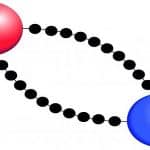An Electron (e–) is a subatomic particle with a negative electric charge where the atom is made with three particles like protons, electrons & neutrons. All these three particles can form the nucleus of an atom. Every electron carries 1 unit of negative charge like 1.602 x 10-19 coulomb & it has an extremely small mass like 9.10938 x 10-31 kg as compared with a proton and a neutron. An Electron belongs to the first invention of the lepton particle … [Read more...]
